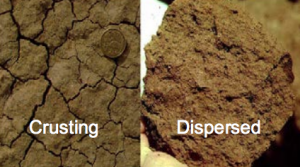What is Soil Porosity?

Photo Credit: https://www.ndsu.edu/soilhealth/wp-content/uploads/2014/07/Soil-Health-Fact-Sheet_Physical-Properties.pdf
The space around mineral and organic soil particles or volume of pores in the total volume of soil occupied by air and water. Pore types are macro, capillary and micro. Pore size distribution can be used to predict water holding capacity, plant available water, infiltration rate and air to water ratio. Soil porosity is affected by organic matter levels, aggregation, shrinking and swelling of clay particles, dispersion caused by low calcium levels versus sodium and magnesium, tillage, and traffic.
Do you have an excellent resource that isn’t listed here? Submit it for consideration.
| Title | Source | Resource type | Short Summary |
|---|---|---|---|
| Soil Physical Properties Fact Sheet | North Dakota State University | Extension Fact Sheet
Not Dated |
Soil physical properties affect the behavior of soil and the functional processes required to meet environmental and human needs |
| Soil Health 101 | Soil Health NEXUS | Extension Webpage
Jan 2017 |
The soil structure is made up of the soil profile, bulk density, and aggregates |
| Soil Properties | Earth Science Week, National Park Service | Lesson Plan
Not Dated |
“Soil porosity” refers to the amount of pores, or open space, between soil particles. Pore spaces may be formed due to the movement of roots, worms, and insects; expanding gases trapped within these spaces by groundwater; and/or the dissolution of the soil parent material. Soil texture can also affect soil porosity |
| Soil Health Assessments: Grass Soil Pit and Row Crop Soil Pit | Soil Health Nexus | How-to Videos
May 2019 |
Using soil pits can show many properties of soil. In the video above, Gene Campbell with the NRCS assesses a grass soil pit. In the video below, Travis Harper with University of Missouri Extension assesses a row crop soil pit. |
| Title | Source | Resource type and date | Short Summary |
|---|---|---|---|
| Soil and Water Relationships | Noble Research Institute | Blog post from an independent research institute
Sep 2001 |
Soil texture and structure greatly influence water infiltration, permeability, and water-holding capacity. Soil porosity refers to the space between soil particles, which consists of various amounts of water and air. Porosity depends on both soil texture and structure. |
| Title | Source | Resource type and date | Short Summary |
|---|---|---|---|
| Porosity and Pore Size Distribution | U.S. Geological Survey | Peer-Reviewed Publication
2004 |
A soil’s porosity and pore size distribution characterize its pore space, that portion of the soil’s volume that is not occupied by or isolated by solid material. |
Last reviewed 10/1/19